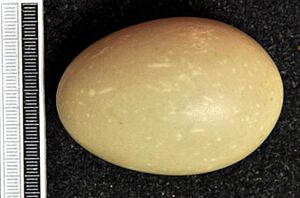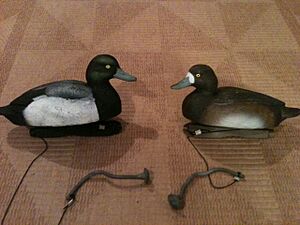Greater scaup facts for kids
Quick facts for kids Greater scaup |
|
|---|---|
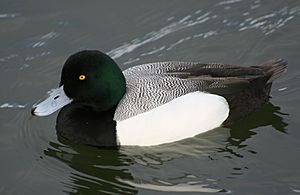 |
|
| Adult male in California | |
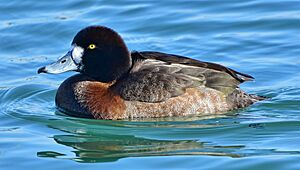 |
|
| Adult female in Ontario | |
| Conservation status | |
| Scientific classification | |
| Genus: |
Aythya
|
| Species: |
marila
|
| Subspecies | |
|
A. m. marila (Linnaeus, 1761) |
|
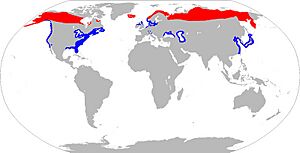 |
|
| Range of Aythya marila | |
| Synonyms | |
|
Anas marila Linnaeus, 1761 |
|
The greater scaup (Aythya marila) is a medium-sized diving duck. In Europe, it's often just called "scaup." In North America, some people call it "bluebill." It's a bit bigger than its close relative, the lesser scaup.
These ducks spend their summers raising families in places like Alaska, northern Canada, Siberia, and the northern parts of Europe. When winter comes, they fly south. You can find them along the coasts of North America, Europe, and Japan during the colder months.
Male greater scaup, called drakes, are larger than females. They have rounder heads, bright blue bills, and yellow eyes. Their heads are dark with a green shine, their chests are black, and their bellies are white. They also have a white stripe on their wings. Female scaup are mostly brown with white on their wings. Their bills are a duller blue, and they have white patches on their faces.
Greater scaup build their nests near water, often on islands in northern lakes or on floating plants. They start having ducklings when they are two years old. Male scaup perform a special dance to attract females. This happens when they fly back to their summer homes. After this, they form pairs for the breeding season. Females lay six to nine olive-colored eggs. These eggs hatch in about 24 to 28 days. The baby ducklings are covered in soft down feathers and can follow their mother to find food right after they hatch.
Greater scaup eat water creatures like molluscs, plants, and insects. They get their food by diving underwater. These ducks often gather in huge groups called "rafts," which can have thousands of birds! While they face threats from human activities, they are also hunted by animals like owls, skunks, raccoons, foxes, and coyotes. Sadly, the number of greater scaup has been going down since the 1980s. However, they are still listed as a species of "least concern" on the IUCN Red List, which means they are not currently in danger of disappearing.
Contents
What is a Greater Scaup?
The greater scaup was first officially described in 1761 by a scientist named Carl Linnaeus. He gave it the scientific name Anas marila. Later, in 1822, another scientist named Friedrich Boie placed it in its own group, or genus, called Aythya.
The name Aythya comes from an ancient Greek word for a seabird. The word marila comes from a Greek word meaning "charcoal embers" or "coal dust." This might refer to the duck's dark coloring.
Scientists recognize two main types, or subspecies, of greater scaup. One is found from northern Europe to eastern Siberia. The other lives in North America. These two types look slightly different, especially in the shape of their heads and the patterns on their feathers.
Scientists have studied the bones and skin of diving ducks. They found that the greater scaup and the lesser scaup are very closely related. The tufted duck is their next closest relative.
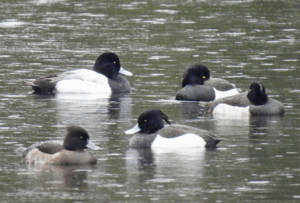
Greater Scaup Appearance
Adult greater scaup are about 39 to 56 centimeters (15 to 22 inches) long. Their wings can spread out 71 to 84 centimeters (28 to 33 inches). They weigh between 726 and 1360 grams (1.6 to 3 pounds). They have bright blue bills and yellow eyes. They are also about 20% heavier and 10% longer than the lesser scaup.
Male scaup have dark heads with a green shine. Their chests are black, their backs are light, and their tails are black. Their undersides are white. The male's belly and sides are a bright white. Their necks, chests, and tail feathers are a shiny black. The upper part of their wings has a white stripe that goes all the way to the wingtip. Both male and female scaup have gray legs and feet.
Female scaup have brown bodies and heads. They have white markings on their wings, similar to the males, but a bit duller. They also have a white band and brown oval patches at the base of their bills. Their bills are a slightly duller blue than the males'. Young greater scaup look a lot like adult females.
It can be tricky to tell greater scaup from lesser scaup in the wild. Greater scaup usually have rounder heads. Their white wing stripe is also longer and more noticeable. Their bills tend to be bigger and wider, often with a large black tip.
Where Greater Scaup Live
The greater scaup lives all around the northern parts of the world. They breed within the Arctic Circle in both Europe and Asia, and in North America. They spend their summers in Alaska, Siberia, and the northern parts of Europe. You can also find them in Asia, and they live in the Aleutian Islands all year.
Their summer homes are usually wet, marshy areas called tundra. They also like islands in freshwater lakes. In the fall, greater scaup fly south for the winter. They spend the winter along the Pacific and Atlantic coasts of North America. They also winter on the coasts of northwest Europe, the Caspian Sea, the Black Sea, and the coasts of Japan, the Yellow Sea, and the East China Sea. During winter, they live in coastal bays, estuaries (where rivers meet the sea), and sometimes on inland lakes like the Great Lakes.
In Europe, greater scaup breed in Iceland, the northern coasts of the Scandinavian peninsula, and parts of Russia near the Arctic Sea. They spend their winters in the British Isles, western Norway, and along the coast from France to Poland. They also winter in the Alps and around the Black and Caspian Seas.
In North America, greater scaup spend their summers in places like Newfoundland and Labrador, Hudson Bay, and northern parts of Yukon and Manitoba. They winter along the coasts of North America, from British Columbia down to Florida. They also spend winters on the shores of the Great Lakes and the Gulf of Mexico.
Greater Scaup Life Cycle and Behavior
Breeding and Reproduction
Greater scaup breed in the cold, open lands of the tundra and in northern forests. About 75% of the North American population breeds in Alaska. They usually build their nests on islands in large northern lakes. Greater scaup start breeding when they are two years old.
Male greater scaup make a soft, quick whistling sound to get the attention of females during courtship. This happens from late winter to early spring, as they fly back to their breeding grounds. Female greater scaup make a rough "arrr-arrr-arrr" sound. Their courtship is quite fancy and leads to the formation of pairs that stay together for the breeding season.
Pairs often nest close to each other in large groups. They usually choose a spot near water, like an island, a shoreline, or a floating mat of plants. The female makes a shallow dip for the nest and lines it with her soft down feathers. After the female lays her eggs, the male leaves her. He joins other males at a large, quiet lake to molt (shed his old feathers). These molting lakes can be close to the breeding areas or far away. The same ducks often use these lakes every year.
The female lays six to nine olive-colored eggs. She sits on them to keep them warm for 24 to 28 days until they hatch. If a nest has more eggs, it might mean other scaup, or even other kinds of ducks, laid eggs there too. Baby scaup are covered with down feathers when they hatch. They can walk, swim, and find their own food very soon after hatching. However, they can't fly until they are 40 to 45 days old. The small, vulnerable ducklings follow their mother, who protects them from animals that might try to eat them.
Feeding Habits
Greater scaup dive underwater to find their food. They then eat it on the surface. They mostly eat molluscs (like snails and clams), water plants, and water insects. In the summer, they also eat small water crustaceans (like tiny crabs). There was even a report of some greater scaup eating hibernating leopard frogs in Chicago!
In freshwater areas, greater scaup will eat seeds, leaves, stems, and roots of plants. This includes plants like sedges, pondweeds, muskgrass, and wild celery. Because of their webbed feet and weight, greater scaup can dive up to 6 meters (20 feet) deep. They can stay underwater for up to a minute! This allows them to reach food that other diving ducks can't get to.
Threats to Greater Scaup
Animals that hunt greater scaup include owls, skunks, raccoons, foxes, and coyotes. Humans also hunt them. Greater scaup sometimes get caught in fishing nets and drown. They can also get avian influenza (bird flu), which could threaten their populations in the future.
The biggest danger to greater scaup is when their homes are damaged. This happens because of human development and pollution. When greater scaup are molting or in their winter homes, they can be harmed by chemicals. Oil spills and sewage pollution also threaten these ducks. A large part of the greater scaup population spends winter in busy coastal areas. This means they are exposed to high levels of pollution and heavy metals in their food and habitat.
Scientists studying scaup migration found that many female scaup had high levels of selenium in their bodies. Selenium is a natural element, and a tiny bit is needed for animals to live. But too much selenium can be very harmful and can stop female ducks from having babies. When greater scaup migrate, they are at risk of eating too much selenium from invasive zebra mussels. This is one reason why their population is decreasing.
Greater Scaup Conservation
The IUCN Redlist lists greater scaup as a species of "least concern." This means they are not currently in danger of disappearing. However, their numbers have been going down steadily since the 1980s. When scientists count scaup from the air, they count greater and lesser scaup together because they look so similar. It's thought that greater scaup make up about 11% of the total scaup population.
Some of the main reasons for their decline include losing their homes, pollution, changes in their breeding areas, and fewer females surviving. In 2010, a survey estimated there were about 4.2 million scaup in America. However, a worldwide survey estimated there were 1.2 to 1.4 million adult greater scaup.
Scientists also use a banding program for greater scaup. They place metal bands on the ducks' legs. If a scaup is hunted or caught by another group, the number on the band can be reported. This helps biologists learn important information about how the ducks migrate, how many are hunted, and how many survive.
Greater Scaup and Humans
Greater scaup are a popular game bird in North America and Europe. People hunt them in countries like Denmark, Germany, and the United Kingdom for sport and sometimes for commercial reasons. Hunters use shotguns to shoot them while they are flying. This is a challenge because greater scaup can fly very fast, up to 121 kilometers per hour (75 mph)!
Hunters often use special hunting blinds or layout boats, which are low boats that hunters lie inside. They also use decoys, which are fake ducks, to attract the birds. These decoys are often set up to look like a large group of scaup, with an open space for real ducks to land.



